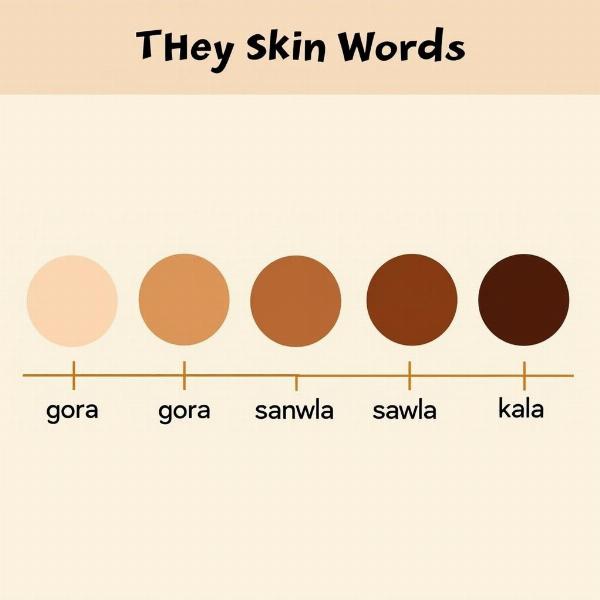Understanding how to discuss skin tone in Hindi can be tricky, especially with the cultural nuances surrounding complexion. “Skin tone meaning in Hindi” encompasses various terms, reflecting not only the physical shade but also societal perceptions. This exploration dives into the common vocabulary used to describe skin tones in Hindi, aiming to provide a clear and comprehensive guide.
Decoding “Rang” (रंग): The Foundation of Color in Hindi
The Hindi word “rang” (रंग) is fundamental to understanding color terminology, including skin tones. It broadly translates to “color,” laying the groundwork for more specific descriptions. Just as “rang” encompasses the vibrant hues of a rainbow, it also covers the spectrum of human complexions. Understanding “rang” helps in grasping the context of skin tone descriptions in Hindi.
Common Hindi Words for Skin Tone
Several words describe skin tones, often drawing comparisons to natural elements. “Gora” (गोरा) generally refers to fair skin, often associated with beauty standards. “Sanwla/Sanwali” (सांवला/सांवली) describes a wheatish or dusky complexion, a common and celebrated skin tone in India. “Kala/Kali” (काला/काली) denotes dark skin, and while sometimes used negatively due to societal biases, its original meaning simply refers to the color black. These terms are crucial for anyone seeking to understand “skin tone meaning in Hindi.”
 Hindi Skin Tone Chart
Hindi Skin Tone Chart
Cultural Significance of Skin Tone in India
Historically, skin tone has held cultural significance in India, influencing social perceptions and even impacting marital prospects. While these perceptions are evolving, understanding their historical context provides valuable insight into the language surrounding skin tone. “Skin tone meaning in Hindi” is not just about vocabulary; it’s about understanding the cultural baggage associated with these terms.
Addressing Colorism in India
It’s important to acknowledge the issue of colorism, a form of prejudice based on skin tone, which persists in some segments of Indian society. While discussions about skin tone are common, it’s crucial to promote inclusivity and challenge discriminatory attitudes. Understanding “skin tone meaning in Hindi” also involves recognizing the negative connotations certain words can carry and advocating for a more positive and accepting approach to discussing complexion.
Beyond Basic Terminology: Describing Skin Tone Nuances
Beyond the basic terms, Hindi offers a rich vocabulary to describe nuances in skin tone. Words like “ujla” (उजला) suggest brightness and radiance, while “phika” (फीका) can denote a dull or pale complexion. “Chamkila” (चमकीला) implies a glowing skin tone. These subtle distinctions reflect the depth and complexity of “skin tone meaning in Hindi.”
Skin Tone in Literature and Poetry
Skin tone has often been a subject of description in Hindi literature and poetry, with metaphors and similes used to evoke specific imagery. From comparing fair skin to the moon or dark skin to the rich earth, these literary expressions further enhance our understanding of “skin tone meaning in Hindi.”
Conclusion: A Comprehensive Understanding of Skin Tone in Hindi
Understanding “skin tone meaning in Hindi” requires navigating not just vocabulary but also cultural context and historical baggage. While words like “gora,” “sanwla,” and “kala” provide a basic framework, the nuances and societal perceptions surrounding skin tone add layers of complexity. By exploring the various terms and acknowledging the cultural significance, we can foster a more informed and sensitive approach to discussing skin tone in Hindi.
FAQ:
- What is the most common word for fair skin in Hindi? “Gora” (गोरा) is the most common word for fair skin.
- How do you say “wheatish complexion” in Hindi? “Sanwla/Sanwali” (सांवला/सांवली) is used for wheatish or dusky complexion.
- Is “kala” (काला) always a negative term? While sometimes used negatively due to colorism, “kala” simply means black and isn’t inherently negative.
- Are there other words besides “gora,” “sanwla,” and “kala” to describe skin tone? Yes, words like “ujla,” “phika,” and “chamkila” describe nuances in skin tone.
- Why is understanding the cultural context of skin tone important? Cultural context helps understand the societal perceptions and historical baggage associated with skin tone terminology.
Looking for accurate and culturally sensitive Hindi translations?
Meaning-Hindi.in is your one-stop solution for all your Hindi translation needs. We specialize in various translation services, including business, legal, technical, website localization, educational, and specialized translations. Our expert linguists ensure accuracy and cultural sensitivity, capturing the true essence of your message. Whether you need to translate documents, website content, or legal contracts, our team is here to help. Contact us at [email protected] or call +91 11-4502-7584 for a seamless translation experience. Meaning-Hindi.in is committed to delivering high-quality, culturally relevant translations that bridge language barriers.